Vera and Donald Blinken Open Society Archives
Nuclear Disarmament and the Budapest Memorandum: “the Arrival of a Safer Era for the World”?
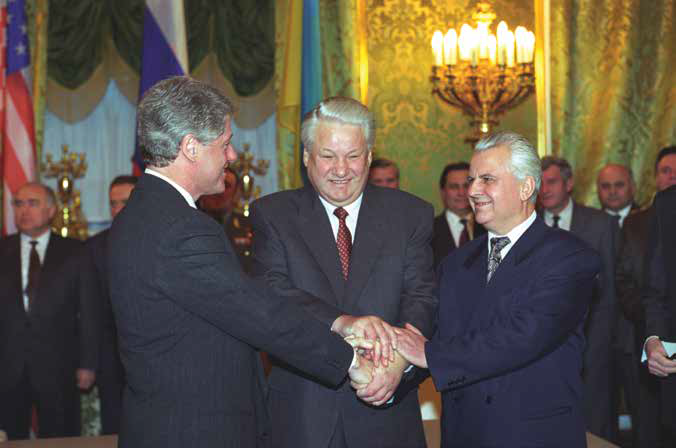 On December 5, 1994, an event took place in Budapest, Hungary, which became the final and defining step in a series of decisions toward the third-largest nuclear state abandoning its nuclear arsenal and becoming a non-nuclear-weapon state. That country was Ukraine. With the collapse of the USSR, Ukraine took third place in the list of nuclear states, behind the United States and the Russian Federation. Leonid Kuchma (president of Ukraine from 1994 to 2005) handed over Ukraine’s accession to the Treaty on the Non-Proliferation of Nuclear Weapons in exchange for security assurances the leaders of the US, Russia, and the UK pledged to give to the country. The document containing those assurances went down in history as the Budapest Memorandum, signed on December 5, 1994, in Budapest.
On December 5, 1994, an event took place in Budapest, Hungary, which became the final and defining step in a series of decisions toward the third-largest nuclear state abandoning its nuclear arsenal and becoming a non-nuclear-weapon state. That country was Ukraine. With the collapse of the USSR, Ukraine took third place in the list of nuclear states, behind the United States and the Russian Federation. Leonid Kuchma (president of Ukraine from 1994 to 2005) handed over Ukraine’s accession to the Treaty on the Non-Proliferation of Nuclear Weapons in exchange for security assurances the leaders of the US, Russia, and the UK pledged to give to the country. The document containing those assurances went down in history as the Budapest Memorandum, signed on December 5, 1994, in Budapest.
Soviet propaganda film Boevye Svoistva Iadernogo Oruzhiia adapted by the Hungarian Civil Defense Alliance.
Excerpt from the full film.
(Blinken OSA Archivum, Paranoia Archive)
After the Nuclear Non-Proliferation Treaty (NPT), advocating nuclear disarmament, was approved by the United Nations General Assembly and has been open for signing since 1968, the most important step in nuclear disarmament was the signing of the Strategic Arms Reduction Treaty, or START-1. This bilateral treaty was signed in Moscow by US President George H. W. Bush and Soviet President Mikhail Gorbachev on July 31, 1991. A few months later, however, the USSR collapsed, and four independent states with nuclear weapons appeared; in addition to the Russian Federation, these were Ukraine, Kazakhstan, and Belarus. While the Russian Federation has become the legal successor fulfilling the obligations formulated in the START-1 treaty, further negotiations became necessary for the other countries to renounce their nuclear weapons. The Lisbon Protocol, signed in May 1992, recognized the independent states as successors of the USSR under the terms of the START-1 treaty, and obligated them to completely abandon nuclear weapons and join the NPT as non-nuclear-weapon states. Consequently, Belarus joined the NPT in June 1993, followed by Kazakhstan in early 1994. In November 1994, following a longer and heated debate, the Ukrainian Parliament (the Verkhovna Rada) passed a law on joining the NPT as a non-nuclear state, which, however, entered into force only under the condition that the nuclear powers provided Ukraine with security guarantees articulated in an appropriate international legal document.
The Budapest Memorandum was what formalized these guarantees: the Memorandum on Security Assurances in Connection with Ukraine’s Accession to the Treaty on the Non-Proliferation of Nuclear Weapons was signed on December 5, 1994, in Budapest, Hungary, against the backdrop of the fourth summit of the Conference on Security and Co-Operation in Europe (CSCE, December 5-6, 1994). The document bears the signatures of President Boris Yeltsin for the Russian Federation, President William J. Clinton for the United States of America, President Leonid Kuchma for Ukraine, and Prime Minister John Major for the United Kingdom of Great Britain and Northern Ireland, as pictured below. With the Memorandum signed, Ukraine acceded to the NPT, started to dismantle and remove the world’s third-largest nuclear arsenal, and agreed, as a non-nuclear-weapon state, not to develop or acquire nuclear weapons in the future.
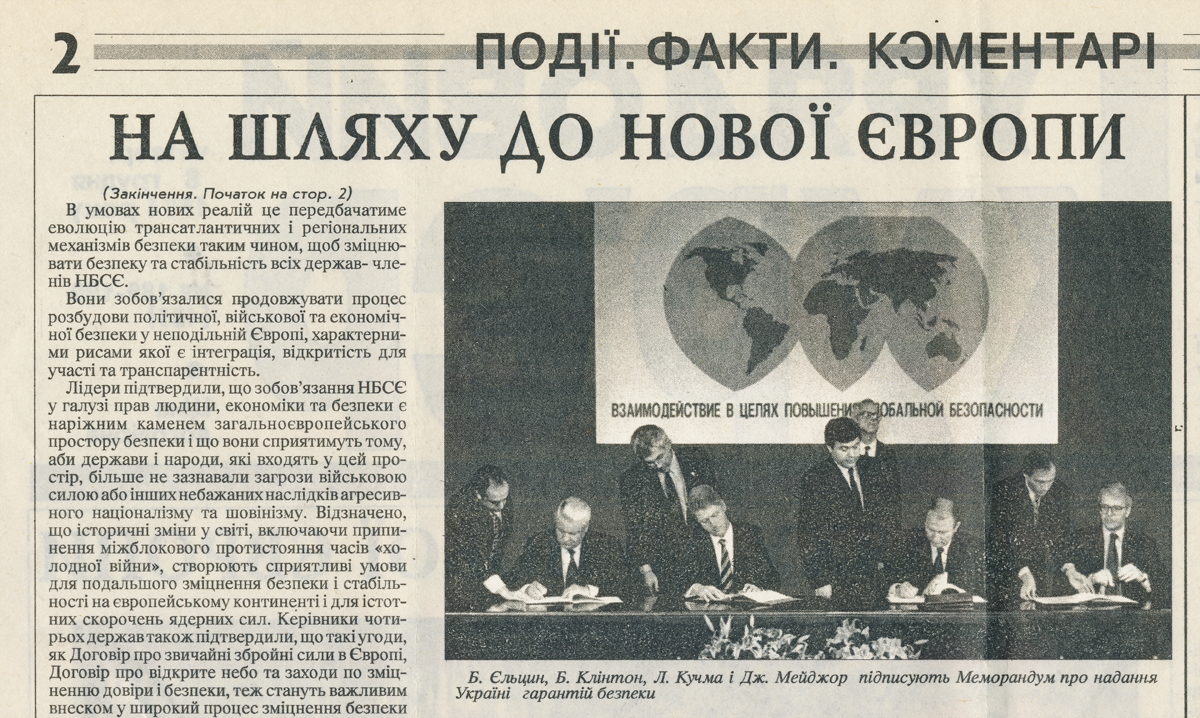 Photo of the signing ceremony of the Budapest Memorandum in the Ukrainian daily Uryadovy Kuryer.
Photo of the signing ceremony of the Budapest Memorandum in the Ukrainian daily Uryadovy Kuryer.
(Blinken OSA Archivum, Library)
In return, the Budapest Memorandum listed the security assurances offered to Ukraine. (Kazakhstan and Belarus received the same assurances in identical but separate memoranda also signed in Budapest.) The Memorandum consists of six points, through which the signing countries “reaffirmed their commitment to”:
- to respect the independence, sovereignty and the existing borders of Ukraine;
- their obligation to refrain from the threat or use of force against the territorial integrity or political independence of Ukraine, and that none of their weapons will ever be used against Ukraine except in self-defense;
- refrain from economic coercion designed to subordinate to their own interest the exercise by Ukraine of the rights inherent in its sovereignty;
- to seek immediate United Nations Security Council action to provide assistance to Ukraine, if Ukraine should become a victim of an act of aggression or an object of a threat of aggression in which nuclear weapons are used;
- not to use nuclear weapons against any non-nuclear-weapon state party to the Treaty on the Non-Proliferation of Nuclear Weapons, except in the case of an attack on themselves;
- consult in the event a situation raises which raises a question concerning these commitments.
The above are excerpts from the official English version, below is the full text in Ukrainian, as it appeared in the Uryadovy Kuryer (Governmental courier), the official newspaper of the executive branch in Ukraine, also including the signatures:
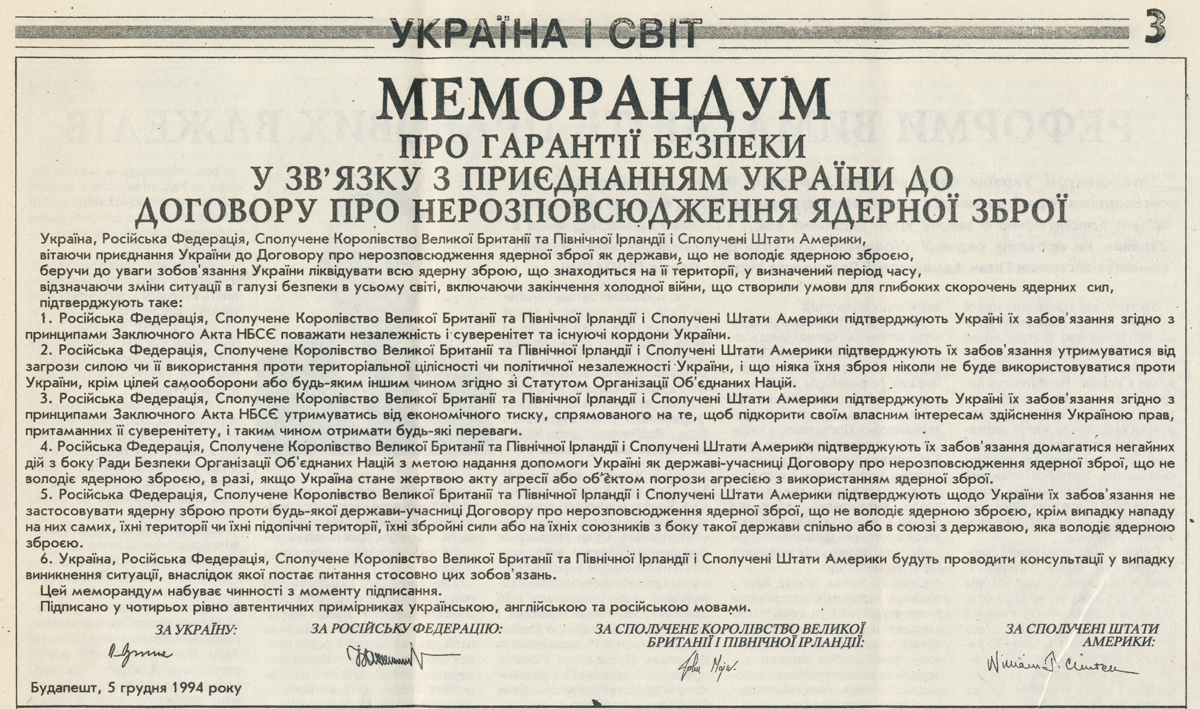 The Budapest Memorandum published in the Ukrainian daily Uryadovy Kuryer.
The Budapest Memorandum published in the Ukrainian daily Uryadovy Kuryer.
(Blinken OSA Archivum, Library)
The Hungarian daily Magyar Nemzet (Hungarian nation) quoted the signatories when calling the Budapest Memorandum an “epoch-making” document “in which the three countries had provided security guarantees to Kyiv, allowing the Ukrainian President to hand over the documents of his country’s accession to the NPT.” Magyar Nemzet also reported President Clinton noting in his address that while “initial negotiations had started still between the United States and the former Soviet Union,” the agreement now “heralded the arrival of a safer era for the world.” The newspaper highlighted that Ukrainian President Leonid Kuchma gave his remarks in Ukrainian, finding it “symbolic that the signing ceremony had taken place at the European security summit.”
To understand the symbolism President Kuchma referred to, in the coming days we will introduce a series of documents preserved at the Blinken OSA Archivum. These archival records will tell us more about the CSCE summit and the gravity of Hungary hosting it, reveal the security assurances the Budapest Memorandum did include and the guarantees it did not, and outline the broader geopolitical moment it was signed at. Finally, already with more context, we will return to the full speech Ukrainian President Kuchma delivered at that particular European security summit, in Budapest, Hungary.
Although the signing ceremony of the Budapest Memorandum was not part of its official program, “the European security summit” President Kuchma alluded to was, of course, the fourth summit of the Conference on Security and Co-Operation in Europe (CSCE). CSCE was initiated in 1973 to establish a dialog across the Iron Curtain and to advocate for human rights in the Socialist Bloc. The first and maybe most significant result of CSCE was the final document of its first summit, held in Helsinki in 1975: in a previous blogpost, we called it an unintentional effect of the Helsinki Final Act that it reinforced and justified the emergence and activity of human rights groups throughout Eastern Europe, eventually contributing to the regime changes in the late 1980s, early 1990s. Responding the these changes and the collapse of the Soviet Union, CSCE turned into today’s Organization for Security and Co-operation in Europe (OSCE) at its fourth summit, organized in Budapest in December 5–6, 1994. We will introduce documents related to the conference in the next chapter of this series, but first, we look at the symbolic meaning of Budapest hosting it, as well as the signing ceremony of the Budapest Memorandum.
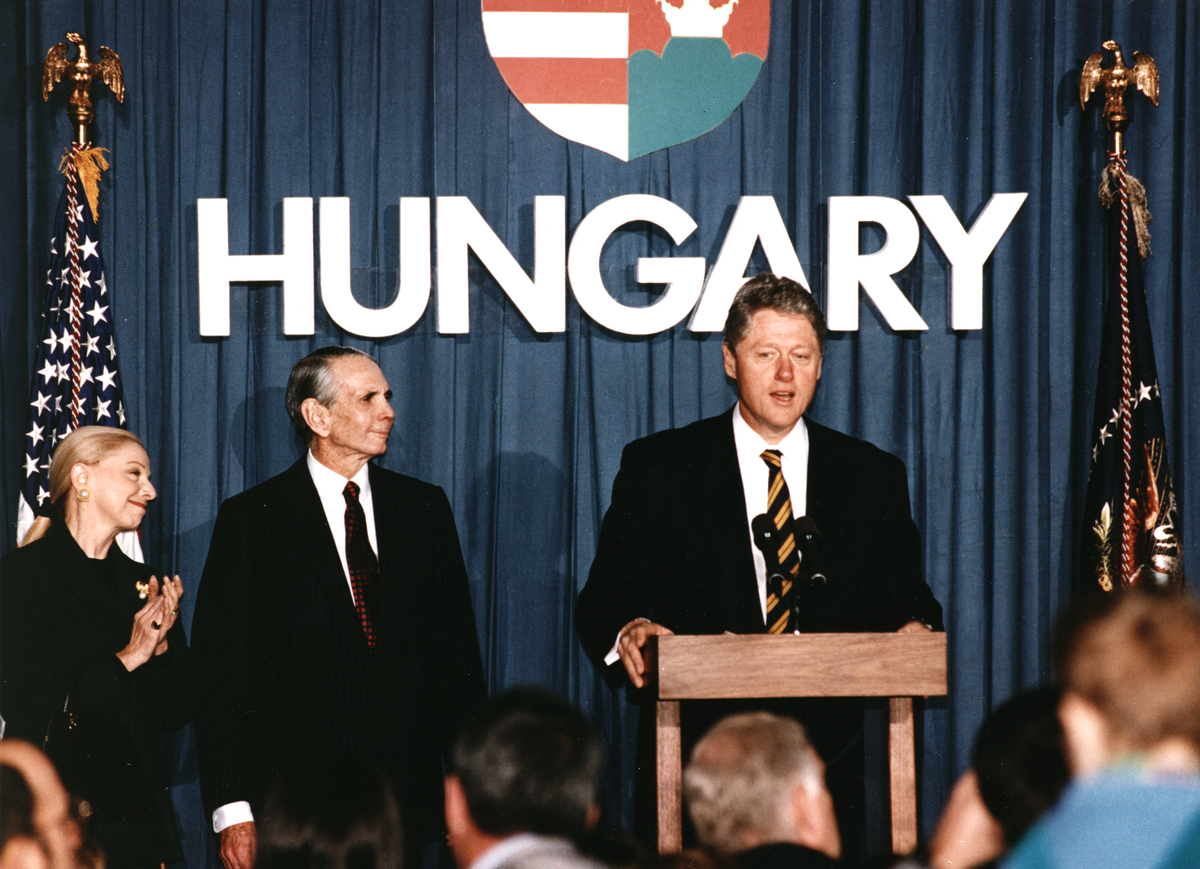
Ambassador Donald M. Blinken and his wife, Vera Blinken, standing next to President Bill Clinton in Budapest on December 5, 1994.
(HU OSA 367-0-3 Vera and Donald Blinken Papers, Vera Blinken Personal Files)
Not much detail on the signing ceremony’s preparations were made public at the time, however, it is known that Donald M. Blinken, US Ambassador to Hungary from that year until 1997, who passed away last September, played an instrumental role in it. Preserving both the Vera and Donald Blinken Papers—comprising correspondence, press clippings, and photographs related to Ambassador Blinken’s ambassadorship in Hungary—and the Records of the Radio Free Europe/Radio Liberty Research Institute—media monitoring and analysis accumulated by the Radios—the Blinken OSA Archivum provides opportunity for a deeper understanding of the event. Below, we share Ambassador Blinken’s article published in December 1994, and an internal wire from RFE/RL.
Received at the Munich headquarters of RFE/RL on December 5, 1994, at 8:32 p.m., the internal wire below contains excerpts from President Clinton’s address delivered at the US Embassy. From the context it can be derived that this event took place following the signing ceremony:
RFE/RL wire on President Clinton’s speech at the US Embassy in Hungary on December 5, 1994.
(HU OSA 300-120-8 Records of RFE/RL Research Institute, Western Press Archives, Biographical Files)
A few weeks after the CSCE summit, Ambassador Blinken published an article in the Budapest Sun, an English-language weekly based in Hungary (the same text appeared in Hungarian in the leading Hungarian daily, Népszabadság), to reflect on his first year as Ambassador to Hungary. “During the recent CSCE summit, the eyes of the world were focused on Budapest,” he writes, reaffirming Hungary’s suitability to host such an event. Echoing President Clinton, he acknowledges “the significant strides forward that democracy has made in Hungary since 1989” and the consequent progress in US–Hungarian relations:
Ambassador Donald M. Blinken’s article on US–Hungarian relations in the Budapest Sun, published on December 22, 1994.
(HU OSA 367-0-1 Vera and Donal Blinken Papers, Donald Blinken Ambassadorial Files)
Titled Towards a Genuine Partnership in a New Era, the final document of the 1994 Budapest summit of CSCE was finalized on December 21. The 33-page text below includes the fourth summit’s Declaration and its Decisions. “We are determined to give a new political impetus to the CSCE,” the Declaration (page 2–5) announces. “To reflect this determination, the CSCE will henceforth be known as the Organization for Security and Co-operation in Europe (OSCE).” Recognizing the changing challenges of the twenty-first century, the Declaration notes how “Most vestiges of the Cold War have disappeared. Free elections have been held and the roots of democracy have spread and struck deeper. Yet the path to stable democracy, efficient market economy and social justice is a hard one.”
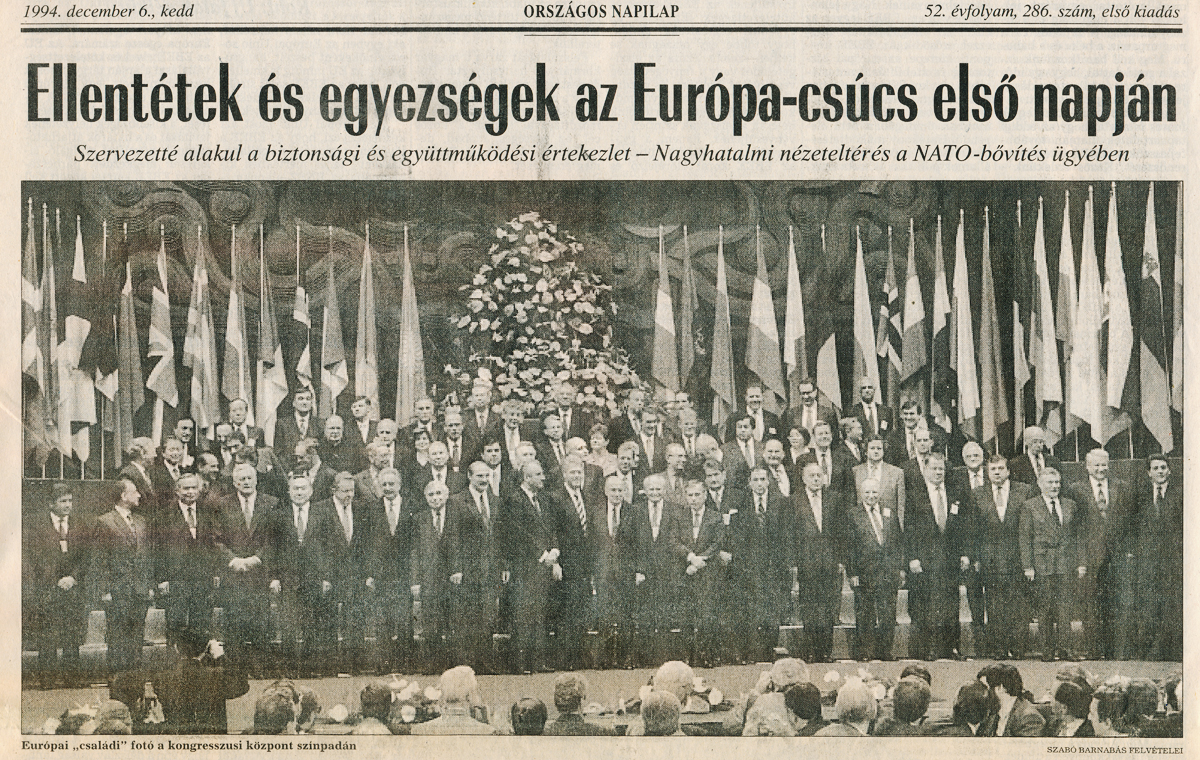
“Family photo” with participating heads of state in the Hungarian daily Népszabadság reporting “Differences and Agreements at First Day of European Summit.”
(Blinken OSA Archivum, Library)
The signing of the Budapest Memorandum was an event that embodied the basic principles of the CSCE in practice: preventive diplomacy, trust- and security-building measures, environmental security, etc. “We are strongly committed to the full implementation and indefinite and unconditional extension of the Treaty on the Non-Proliferation of Nuclear Weapons,” Point 12 of the Budapest Summit Declaration (page 3) stresses, while its Principles Governing Non-Proliferation (page 18–20) endorses “universal adherence to the NPT.” Yet, paradoxically, the Document makes no direct reference either to the Budapest Memorandum, or its parallel signing to the summit.
Final Document of the 1994 Budapest CSCE summit.
(HU OSA 318-0-7 Records of the International Helsinki Federation for Human Rights, CSCE-OSCE Files)
The Blinken OSA Archivum preserves the archive of the International Helsinki Federation (IHF), including documents the human rights organization prepared and accumulated while participating in CSCE-OSCE summits and working groups. At the 1994 Budapest summit, IHF primarily contributed to the human rights section, the results of which are summarized among the final document’s decisions (Decision VIII, “The Human Dimension”, page 21–27). However, besides statements, proposals, and background materials of this working group, the records also include administrative and PR files, such as the Press and NGO Guide, seen below. Of interest is the summit’s schedule (page 11–12), capturing the breadth of an event hosting 53 participating heads of state; and, more importantly, the list of “Photo Opportunities” for the press, recommending, right after “US President Clinton’s arrival” and the “Family Photo” (see above), a certain “NPT Signing Ceremony.” Most probably that meant the signing of the Budapest Memorandum, which this way did, sort of, become part of the CSCE summit program.
Press and NGO Guide of the 1994 Budapest CSCE summit.
(HU OSA 318-0-7 Records of the International Helsinki Federation for Human Rights, CSCE-OSCE Files)
One of the possible explanations for why the Budapest Memorandum did not receive more attention in these documents is that at that moment the possible conflict on Ukraine’s territory was hypothetical, unlike the several large-scale conflicts that indeed were taking place in Europe and the post-Soviet space, and required immediate settlements. “The spread of freedoms has been accompanied by new conflict and the revival of old ones,” the Budapest Summit Declaration warns. “Warfare in the CSCE region to achieve hegemony and territorial expansion continues to occur. Human rights and fundamental freedoms are still flouted, intolerance persist and discrimination against minorities is practiced. The plagues of aggressive nationalism, racism, chauvinism, xenophobia, anti-Semitism, and ethnic tension are still widespread.”
We will address these in a later chapter of this series.
The event that received the largest press attention at the 1994 Budapest CSCE summit certainly was the public “clash” between US President Bill Clinton and Russian President Boris Yeltsin. Both spoke at the conference’s Second Plenary meeting on December 5, as recorded in the summit schedule of the Press and NGO Guide (see in Part 3). Even that document hints at the uncertainty regarding Clinton’s arrival; eventually, he spent “seven hours on the ground in Hungary,” during which he signed the Budapest Memorandum (see in Part 1), addressed the guests at the US Embassy (see in Part 2), and spoke at the CSCE summit.
AP video report covering the Budapest summit of CSCE in 1994, with speeches by Clinton and Yeltsin,
also capturing the signing of the Budapest Memorandum.
“Clinton was determined to come to the Budapest CSCE summit to show his backing for the transition to democracy and market economies in Eastern Europe,” a Reuter press release received at the RFE/RL headquarters that day at 2:42 p.m. reports. “Clinton said the North Atlantic Treaty Organization was the bedrock of European security and cooperation,” adding, “NATO would help knit together the disparate states of Central and Eastern Europe for collective security. . . . No country outside NATO will be allowed to veto expansion.”
Reuter report on speech US President Clinton delivered at the CSCE summit in Budapest, on December 5, 1994.
(HU OSA 300-120-8 Records of RFE/RL Research Institute, Western Press Archives, Biographical Files)
Yeltsin, portraying Russia as “the Eastern pillar of security and stability,” spoke after Clinton, and immediately objected to NATO’s planned expansion. Below we share the full speech of the Russian President (or it’s non-official English translation, to be precise, preserved at the Blinken OSA Archivum among the CSCE-related files of IHF). “Establishment of a full-fledged all-European organization with a solid legal basis has become a vital necessity for Europe,” Yeltsin declared, proposing CSCE, of which Russia had already been a member, to be this “instrument of peace, stability, and democracy,” and not NATO. “Today, [NATO] is trying to find its place in Europe, not without difficulty. It is important that this search not create new divisions, but promote European unity,” he expressed, and provided the most-quoted statement of the whole summit by warning that “Having just rid itself of the Cold War legacy, Europe risks to immerse itself into a ‘cold peace.’”
Unofficial translation of speech Russian President Boris Yeltsin delivered at the CSCE summit in Budapest, on December 5, 1994.
(HU OSA 318-0-7 Records of the International Helsinki Federation for Human Rights, CSCE-OSCE Files)
Unlike Yeltsin, Clinton did mention the signing of the Budapest Memorandum. “He welcomed historic agreements signed at Budapest on Monday with the former Soviet states of Ukraine, Belarus and Kazakhstan renouncing nuclear weapons and finally bringing into force long-delayed arms cuts under the START-1 treaty,” the same Reuter release reported. “But while celebrating that landmark, Europe had to face the war on its doorstep in Bosnia, Clinton said. ‘The terrible conflict in Bosnia rages not 300 miles from this city,’ said Clinton, identifying the central issue undermining a summit supposed to set a new security framework.”
In the next chapter, we will recall another terrible war ongoing at the time, setting the broader historical scene of the Budapest Memorandum.
The moment of signing the Budapest Memorandum took place against the backdrop of many “terrible conflicts” in Europe—in Nagorno-Karabakh, in Transnistria, in Bosnia. And it was also at this broader historical moment that Boris Yeltsin and his government decided on a military resolution to the situation in the Chechen Republic.
At the time of the collapse of the USSR (the parade of sovereignties), a group of Chechen leaders led by Dzhokhar Dudayev announced the formation of an independent Chechen Republic, its secession from the Soviet Union and its sovereignty—which Russia did not recognize. For several years, the situation in the region has escalated, ammounting to an arcmed conflict by autumn 1994; in November, the pro-Russian opposition of Dudayev made an unsuccessful military attempt to storm Chechnya’s capital. As it turned out, the FSK supported the attack with military personnel, as well as armored vehicles and aircrafts.
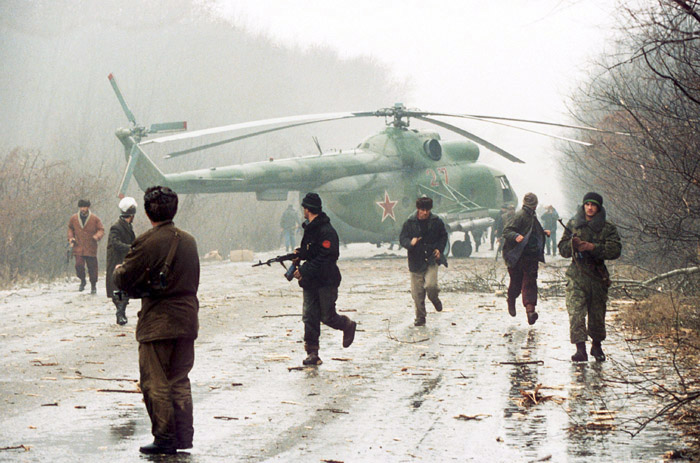
A Russian Mi-8 helicopter shot down by Chechen fighters near the Chechen capital, Grozny, in December 1994.
(Wikimedia Commons)
Six days before the Budapest security conference, on November 29, Yeltsin signed an ultimatum demanding “the participants in the armed conflict in the Chechen Republic” to “lay down their arms” within 48 hours. “Blood is being shed in the ancient land of the Caucasus, which is an inseparable part of our fatherland. . . . absolutely innocent people are perishing. The number of orphans is multiplying. The constitutional rights and freedoms of citizens are being trampled. Thousands of hapless people are being turned into refugees,” the text stated. “The hope of an independent solution to the internal Chechen conflict has been completely exhausted. . . . The entire responsibility for Chechnya’s fate, for the life and health of all its citizens, lies with me, the President of Russia.” The ultimatum declared that in case its demands were not met, “all the forces and means at the disposal of the state will be used to put a stop to the bloodshed, to protect the life, rights, and freedoms of Russian citizens, and to restore constitutional legality, law and order, and peace in the Chechen Republic.”
Ultimatum signed by President Yeltsin, issued on November 29, 1994.
(HU OSA 300-120-8 Records of RFE/RL Research Institute, Western Press Archives, Biographical Files)
Six days after the Budapest summit—where Yeltsin named Russia “the Eastern pillar of security and stability”—on December 11, President Yeltsin addressed the nation, informing Russian citizens that “units of the Interior Ministry and the Defense Ministry of the Russian Federation moved into the Chechen Republic. The government’s actions have been prompted by the threat to the integrity of Russia, to the safety of its citizens both in Chechnya and beyond its borders.” As Russian troops entered Chechnya “to protect its citizens from armed extremism,” Yeltsin ordered “all officials charged with the responsibility of restoring constitutional order in the Chechen Republic not to use violence against civilians and to take them under protection.”
President Yeltsin’s December 11, 1994 speech.
(HU OSA 300-120-8 Records of RFE/RL Research Institute, Western Press Archives, Biographical Files)
Thus began the First Chechen War (1994–1996), which claimed the lives of 6,000 Russian servicemen; Chechen deaths are estimated at 30,000 to 50,000, including the civilian victims of the war crimes committed by Russian troops. Officially in Russia, this military conflict was not called a war; it was called “measures to restore constitutional order in Chechnya,” or “peacekeeping operations.” Another recurrent phrase regarding the situation in Chechnya was “internal”; Yeltsin in his November 29 ultimatum addressed an “internal Chechen conflict,” while Russian Foreign Minister Andrei Kozyrev claimed that, “Chechnya is an internal affairs of Russia, and we do not discuss it with our international partners.”
While the Bosnian War or the Nagorno-Karabakh conflict were on the agenda of the CSCE summit, we have found no trace of the worsening situation in the Chechen Republic having been directly raised with the gravity it would have required. Which, according to earlier press reports, was exactly what President Yeltsin had intended to achieve. A Reuter report from December 4—one day before the Budapest summit (and the signing of the Budapest Memorandum)—noted that, “Worried by the crisis in the breakaway region of Chechnya, and other conflicts lapping at Russia’s southern frontiers, Moscow wants the CSCE to become Europe’s dominant security organization,” and not NATO, “since it is a leading member” of the former. At the same time, however, Russia was “resisting calls for the CSCE to monitor and control its peacekeeping effort in troubled former Soviet Republics.” The international community did, it seems, consider Chechnya an internal affair of Russia, and failed to recognize in time the true meaning of the words “operation,” “internal,” and “peacekeeping.”
Reuter summary on President Yeltsin prior to the Budapest CSCE summit, December 4, 1994.
(HU OSA 300-120-8 Records of RFE/RL Research Institute, Western Press Archives, Biographical Files)
In the next chapter, we will return to the Budapest Memorandum, and compare the security assurances it did provide to Ukraine with the security guarantees Ukraine had originally demanded.
In the previous chapters, we have explored the broader context of the Budapest Memorandum, which now allows for a more precise understanding of its contents. As outlined in the introduction to this series, what the Budapest Memorandum achieved was that it provided security assurances to Ukraine on the parts of the Russian Federation, the United Kingdom, and the United States, which the Ukrainian parliament, the Verkhovina Rada, had made a condition for the country’s becoming a non-nuclear-weapon state.
The Budapest Memorandum concluded a yearslong series of negotiations and disputes between the West, Russia, and Ukraine on the one hand, and between the Ukrainian President and the Rada on the other. In May 1992, Ukraine did sign the Lisbon Protocol, which obliged the country to ratify the START-1 treaty, that, however, did not follow immediately. In November 1993, the Ukrainian parliament adopted a resolution on START-1 ratification, its contents, however, only “angered, rather than reassured, the Russian and US governments,” as well as the Ukrainian government, as it pledged to dismantle only a smaller section of Ukraine’s nuclear arsenal, and renounced the non-nuclear status. Yet, contrasting this resolution with the Budapest Memorandum provides us an opportunity to identify conditions that Ukraine later abandoned in the negotiation process. Below is RFE/RL’s English summary of the 1993 Rada resolution; comparing its phrasing with that of the Budapest Memorandum, one notices two striking differences. First, while the 1993 resolution calls for “security guarantees,” the 1994 Budapest Memorandum records “security assurances,” a “less binding commitment” US lawyers insisted using. Second, the Rada resolution demanded the nuclear powers “to safeguard” Ukraine’s territorial integrity and sovereignty, while in the Budapest Memorandum Russia, the UK, and the US committed “to respect” those.
English summary of the 1993 Rada resolution on START-1 ratification, from John W. R. Lepingwell’s analysis “Negotiations over Nuclear Weapons: The Past as Prologue?,” published in the January 28, 1994 issue of the weekly RFE/RL Research Report.
(HU OSA 300-8-44 Records of RFE/RL Research Institute, Publications Department, RFE/RL Research Report)
Two months (and Clinton’s phone call and visit to Kyiv) later, in January 1994, Ukrainian President Leonid Kravchuk signed a trilateral agreement with Russian President Boris Yeltsin and US President Bill Clinton. On Ukraine’s part, this agreement declared that, “The presidents look forward to the entry into force of the START I Treaty, including the Lisbon Protocol and associated documents, and President Kravchuk reiterated his commitment that Ukraine accede to the Nuclear Non-proliferation Treaty as a non-nuclear-weapon state in the shortest possible time.” While on the parties’ side, “Presidents Clinton and Yeltsin informed President Kravchuk that the United States and Russia are prepared to provide security assurances to Ukraine,” provided that Ukraine acceded to both the START-1 Treaty and the NPT. These assurances already largely overlapped with those in the Budapest Memorandum.

US President Clinton, Russian President Yeltsin, and Ukrainian President Kravchuk, after signing the Trilateral Agreement in Moscow, January 14, 1994.
(Wikimedia Commons/Clinton Digital Library)
As the trilateral agreement President Kravchuk signed did not fully meet the calls of the 1993 parliamentary resolution, Kravchuk attempted to, for the sake of an overarching national consensus, persuade the Rada to approve it. In February 1994, the agreement’s parliamentary debate opened with the President’s speech, broadcast live by the Ukrainian state radio. Below are news agency releases on the session, and excerpts from the president’s speech, transcribed at RFE/RL. In his address, Kravchuk listed the technical (“the dangerous condition of nuclear warheads”), political (“full isolation”), and financial (hundreds of millions of dollars in compensation) reasons to the cause, posing the rhetoric question, “Can we really expect the development of normal—I stress, normal—relation with Russia without deciding this painful problem? If someone thinks we can, then he is deeply mistaken.”
Press agency releases on and excerpts from speech by Ukrainian President Leonid Kravchuk at the Rada debate on the Trilateral Agreement.
(HU OSA 300-120-2 Records of RFE/RL Research Institute, Western Press Archives, Biographical Files)
The Rada voted in favor of ratifying the START-1 treaty, but still rejected the non-nuclear status and the country’s accession to the NPT. In 1994, Ukraine held parliamentary elections in March–April, and presidential elections in June–July. Thus, in November, it was the new Rada that approved the accession to the NPT on condition of what turned out to be the Budapest Memorandum, signed in December by the country’s new President, Leonid Kuchma.
In the final chapter of the series, we will revisit Ukrainian President Kuchma’s speech delivered at the CSCE summit in Budapest, celebrating the Memorandum.
To conclude our series about the Budapest Memorandum, we bring to your attention the full speech Ukrainian President Leonid Kuchma gave at the CSCE summit in Budapest, on December 5, 1994. Kuchma’s address, delivered less than two hours before he signed the Budapest Memorandum, clearly reflects the position of Ukraine 30 years ago; its fears, hopes, and aspirations. In many ways, the new world that the president addressed, the world that Ukraine so wanted to become a part of, could not meet the country’s aspirations in the long run. Kuchma spoke in Ukrainian, but we publish the text’s English translation CSCE participants received at the time; surprisingly, we found no trace of the speech having been published or discussed ever since.
English translation of Ukrainian President Leonid Kravchuk’s speech delivered at the 1994 CSCE summit in Budapest.
(HU OSA 318-0-7 Records of the International Helsinki Federation for Human Rights, CSCE-OSCE Files)
This piercing speech discusses several issues. Here are some landmark snippets:
Already in 1994, the situation around Crimea was tense, due to the division of the Black Sea Fleet. Speaking about the importance of preventive diplomacy, Leonid Kuchma thanked the CSCE for its principled position regarding the inviolability of Ukrainian borders:
A most revealing aspects of the speech is the clear articulation of Ukraine’s belonging to Europe. Kuchma did not ask to join Europe, but presented the country as an integral part of it:
Or:
And, of course, the central theme of the speech was the signing of the Budapest Memorandum:
Kuchma stressed the role that the security assurances played in the process, also highlighting that China, in a separate statement, made similar promises to Ukraine:
Only since 2014, when Russia invaded Crimea and annexed it from Ukraine, Ukraine tried to initiate the Budapest Memorandum four times. Most recently, it was President Zelensky who called “consultations in the framework of the Budapest Memorandum,” in his speech delivered at the Munich Security Conference on February 19, 2022; 5 days before Russia’s full-scale invasion of Ukraine.

